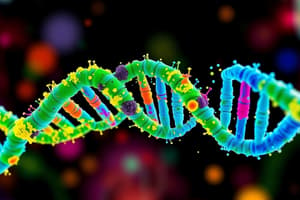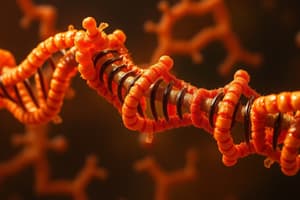Podcast
Questions and Answers
What is the primary function of the 5' cap added during pre-mRNA processing?
What is the primary function of the 5' cap added during pre-mRNA processing?
- To facilitate the binding of ribosomes
- To enhance mRNA translation
- To protect mRNA from degradation (correct)
- To initiate transcription
What role does the Poly-A-Tail serve after pre-mRNA processing?
What role does the Poly-A-Tail serve after pre-mRNA processing?
- It acts as a binding site for exporting processed mRNA. (correct)
- It facilitates mRNA degradation.
- It helps in the recognition of splice sites.
- It initiates protein synthesis directly.
Which of the following is directly involved in the splicing process of pre-mRNA?
Which of the following is directly involved in the splicing process of pre-mRNA?
- Spliceosomes (correct)
- RNA polymerase
- Transcription factors
- Ribosomes
Which of these components are removed from the primary RNA transcript during splicing?
Which of these components are removed from the primary RNA transcript during splicing?
What distinguishes an exon from an intron in the context of mRNA processing?
What distinguishes an exon from an intron in the context of mRNA processing?
Which enzyme is responsible for adding adenine nucleotides to the 3' end of the pre-mRNA?
Which enzyme is responsible for adding adenine nucleotides to the 3' end of the pre-mRNA?
What modification occurs at the 5' and 3' ends of the primary RNA transcript during processing?
What modification occurs at the 5' and 3' ends of the primary RNA transcript during processing?
How does mRNA editing occur in eukaryotic cells after transcription?
How does mRNA editing occur in eukaryotic cells after transcription?
What is the role of the β-subunit in prokaryotic RNA polymerase?
What is the role of the β-subunit in prokaryotic RNA polymerase?
Which subunit of prokaryotic RNA polymerase is involved in transcription initiation?
Which subunit of prokaryotic RNA polymerase is involved in transcription initiation?
How does prokaryotic RNA polymerase proceed during the elongation phase of transcription?
How does prokaryotic RNA polymerase proceed during the elongation phase of transcription?
What signals the prokaryotic RNA polymerase to detach from the DNA template during termination?
What signals the prokaryotic RNA polymerase to detach from the DNA template during termination?
What is required for eukaryotic RNA polymerase II to bind to the DNA template?
What is required for eukaryotic RNA polymerase II to bind to the DNA template?
During the transcription initiation in eukaryotes, what is the significance of the TATA box?
During the transcription initiation in eukaryotes, what is the significance of the TATA box?
What happens to the RNA transcript in prokaryotes after transcription?
What happens to the RNA transcript in prokaryotes after transcription?
What triggers the release of pre-mRNA from RNA polymerase II during termination in eukaryotes?
What triggers the release of pre-mRNA from RNA polymerase II during termination in eukaryotes?
What is the main role of RNA polymerase during transcription?
What is the main role of RNA polymerase during transcription?
What is a key difference in transcription between prokaryotes and eukaryotes?
What is a key difference in transcription between prokaryotes and eukaryotes?
In prokaryotes, transcription initiation primarily involves what structure recognized by RNA polymerase?
In prokaryotes, transcription initiation primarily involves what structure recognized by RNA polymerase?
Which sequence represents the -10 region consensus for prokaryotes?
Which sequence represents the -10 region consensus for prokaryotes?
Which mechanism is primarily involved in the elongation stage of transcription?
Which mechanism is primarily involved in the elongation stage of transcription?
What triggers the termination of transcription?
What triggers the termination of transcription?
Which of the following is a key transcription factor in eukaryotes?
Which of the following is a key transcription factor in eukaryotes?
During the transcription initiation phase in eukaryotes, which process is primarily responsible for forming the RNA polymerase complex?
During the transcription initiation phase in eukaryotes, which process is primarily responsible for forming the RNA polymerase complex?
What is the main difference in transcription termination between prokaryotes and eukaryotes?
What is the main difference in transcription termination between prokaryotes and eukaryotes?
Which statement is true regarding RNA synthesis during transcription?
Which statement is true regarding RNA synthesis during transcription?
Study Notes
Transcription in Prokaryotes: Initiation
- Promoter serves as the DNA sequence where RNA polymerase attaches to initiate transcription.
- Contains two consensus sequences: -10 and -35 regions upstream of the start point.
- RNA polymerase separates the DNA strands and synthesizes complementary mRNA.
- Prokaryotic RNA polymerase is a holoenzyme consisting of five subunits: β, β’, α, α, and σ.
- Each subunit has distinct functions in mRNA synthesis, such as binding ribonucleoside triphosphates or the DNA template.
Transcription in Prokaryotes: Elongation
- During elongation, the σ-subunit is released, allowing RNA polymerase to continue synthesizing mRNA in the 5’-3’ direction.
- RNA nucleotides are added to the growing RNA strand's 3’ end as transcription progresses.
Transcription in Prokaryotes: Termination
- RNA polymerase must be signaled to detach from the DNA template to release the newly synthesized mRNA.
- The transcribed RNA sequence acts as a termination signal.
- Newly formed RNA does not require further modification prior to translation.
Transcription in Eukaryotes: Initiation
- Eukaryotic RNA polymerase requires transcription factors to bind to the DNA template.
- These factors first attach to the promoter region, assisting in recruiting the appropriate polymerase.
- Eukaryotic promoters have a TATA box, differing slightly in sequence from prokaryotes.
Transcription in Eukaryotes: Elongation
- RNA polymerase unwinds the DNA helix and synthesizes RNA by adding nucleotides to the 3’ end of the new RNA strand.
- Newly formed RNA detaches from the DNA template as transcription continues.
Transcription in Eukaryotes: Termination
- RNA polymerase II transcribes a Polyadenylation signal sequence (AAUAAA), which triggers the release of pre-mRNA by associated proteins.
- Pre-mRNA undergoes additional processing before leaving the nucleus.
Pre-mRNA Processing in Eukaryotes
- Transcription results in pre-mRNA, which undergoes processing to form mature mRNA for translation.
- Bacteria do not have a nuclear membrane, allowing simultaneous transcription and translation, whereas eukaryotes must transport mRNA to the cytoplasm.
Pre-mRNA Processing Steps
- 5’ Capping: A 7-methylguanosine cap is added to the 5’ end, protecting mRNA and aiding in translation initiation.
- 3’ Poly-A-Tail: A sequence of adenine nucleotides (50-250) is added to the 3’ end, enhancing stability and exporting processed mRNA.
- Splicing: Involves removing introns (non-coding sequences) and joining exons (coding sequences) to produce mature mRNA, performed by spliceosomes.
Splicing Mechanism
- Spliceosomes identify the 5’ and 3’ ends of introns, facilitate base pairing with small RNAs, and catalyze intron removal and exon joining.
Studying That Suits You
Use AI to generate personalized quizzes and flashcards to suit your learning preferences.
Related Documents
Description
This quiz focuses on the initiation of transcription in prokaryotic cells, detailing the role of RNA polymerase and the promotor sequence. Key concepts include the start point of transcription and the separation of DNA strands. Test your knowledge of these fundamental biological processes.




